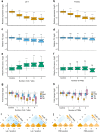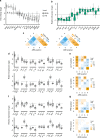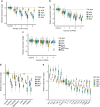PTRE-seq reveals mechanism and interactions of RNA binding proteins and miRNAs
- PMID: 29352242
- PMCID: PMC5775260
- DOI: 10.1038/s41467-017-02745-0
PTRE-seq reveals mechanism and interactions of RNA binding proteins and miRNAs
Abstract
RNA binding proteins (RBP) and microRNAs (miRNAs) often bind sequences in 3' untranslated regions (UTRs) of mRNAs, and regulate stability and translation efficiency. With the identification of numerous RBPs and miRNAs, there is an urgent need for new technologies to dissect the function of the cis-acting elements of RBPs and miRNAs. We describe post-transcriptional regulatory element sequencing (PTRE-seq), a massively parallel method for assaying the target sequences of miRNAs and RBPs. We use PTRE-seq to dissect sequence preferences and interactions between miRNAs and RBPs. The binding sites for these effector molecules influenced different aspects of the RNA lifecycle: RNA stability, translation efficiency, and translation initiation. In some cases, post-transcriptional control is modular, with different factors acting independently of each other, while in other cases factors show specific epistatic interactions. The throughput, flexibility, and reproducibility of PTRE-seq make it a valuable tool to study post-transcriptional regulation by 3'UTR elements.
Conflict of interest statement
The authors declare no competing financial interests.
Figures






Similar articles
-
Highly accessible AU-rich regions in 3' untranslated regions are hotspots for binding of regulatory factors.PLoS Comput Biol. 2017 Apr 14;13(4):e1005460. doi: 10.1371/journal.pcbi.1005460. eCollection 2017 Apr. PLoS Comput Biol. 2017. PMID: 28410363 Free PMC article.
-
Transcriptome-wide analysis reveals spatial correlation between N6-methyladenosine and binding sites of microRNAs and RNA-binding proteins.Genomics. 2021 Jan;113(1 Pt 1):205-216. doi: 10.1016/j.ygeno.2020.12.027. Epub 2020 Dec 16. Genomics. 2021. PMID: 33340693
-
Modeling the combined effect of RNA-binding proteins and microRNAs in post-transcriptional regulation.Nucleic Acids Res. 2016 May 19;44(9):e83. doi: 10.1093/nar/gkw048. Epub 2016 Feb 2. Nucleic Acids Res. 2016. PMID: 26837572 Free PMC article.
-
The coupled and uncoupled mechanisms by which trans-acting factors regulate mRNA stability and translation.J Biochem. 2017 Apr 1;161(4):309-314. doi: 10.1093/jb/mvw086. J Biochem. 2017. PMID: 28039391 Review.
-
Competing Interactions of RNA-Binding Proteins, MicroRNAs, and Their Targets Control Neuronal Development and Function.Biomolecules. 2015 Oct 23;5(4):2903-18. doi: 10.3390/biom5042903. Biomolecules. 2015. PMID: 26512708 Free PMC article. Review.
Cited by
-
Roles of RNA-binding proteins in neurological disorders, COVID-19, and cancer.Hum Cell. 2023 Mar;36(2):493-514. doi: 10.1007/s13577-022-00843-w. Epub 2022 Dec 18. Hum Cell. 2023. PMID: 36528839 Free PMC article. Review.
-
The Untranslated Regions of mRNAs in Cancer.Trends Cancer. 2019 Apr;5(4):245-262. doi: 10.1016/j.trecan.2019.02.011. Epub 2019 Mar 22. Trends Cancer. 2019. PMID: 30961831 Free PMC article. Review.
-
Role of PUM RNA-Binding Proteins in Cancer.Cancers (Basel). 2021 Jan 3;13(1):129. doi: 10.3390/cancers13010129. Cancers (Basel). 2021. PMID: 33401540 Free PMC article. Review.
-
MiRNA-494 enhances M1 macrophage polarization via Nrdp1 in ICH mice model.J Inflamm (Lond). 2020 Apr 25;17:17. doi: 10.1186/s12950-020-00247-3. eCollection 2020. J Inflamm (Lond). 2020. PMID: 32351331 Free PMC article.
-
Experimental capture of miRNA targetomes: disease-specific 3'UTR library-based miRNA targetomics for Parkinson's disease.Exp Mol Med. 2024 Apr;56(4):935-945. doi: 10.1038/s12276-024-01202-5. Epub 2024 Apr 1. Exp Mol Med. 2024. PMID: 38556547 Free PMC article.
References
Publication types
MeSH terms
Substances
Grants and funding
LinkOut - more resources
Full Text Sources
Other Literature Sources

